10 Inspirational Images Of Driver's License Without Taking A Driver's …
페이지 정보
작성자 Jesus 댓글 0건 조회 713회 작성일 25-06-10 09:40본문

Navigating the World Without a Driver's License: Exploring Alternatives and Implications
In today's world, where movement is a cornerstone of every day life, the idea of living without a driver's license might appear complicated. Nevertheless, for some individuals, the choice to forgo a driver's license is a mindful choice driven by numerous factors, including environmental issues, cost, and personal choice. This short article dives into the options to driving and the ramifications of living without a driver's license, offering a thorough guide for those considering this lifestyle.
Understanding the Decision
Selecting not to have a driver's license is an individual choice that can stem from a number of factors. For some, it's a commitment to minimizing their carbon footprint and promoting sustainable living. Others find the cost of owning and maintaining a vehicle prohibitive, while some simply prefer the convenience and freedom of other modes of transportation. No matter the inspiration, living without a driver's license needs mindful planning and a determination to adapt.
Alternatives to Driving
Public Transportation
- Buses and Trains: Public transport systems, such as buses and trains, are typically the most reliable and cost-effective options. They are accessible in most urban areas and supply a structured way to navigate cities and rural areas.
- Subway and Light Rail: In bigger cities, trains and light rail systems offer quick and efficient travel, typically bypassing rush hour and reducing travel time.
Ride-Sharing Services
- Uber and Lyft: These popular ride-sharing apps provide on-demand transport, making it easy to get around without a car. They are particularly useful for late-night travel and in areas with restricted mass transit.
- Carpooling: Joining or forming carpool groups can minimize costs and environmental effect. Many neighborhood platforms and apps assist in carpooling for regular commutes.
Bikes and E-Scooters
- Bicycles: Cycling is a healthy and environment-friendly way to take a trip, particularly for shorter ranges. Lots of cities have dedicated bike lanes and bike-sharing programs to encourage this mode of transportation.
- Electric Scooters: E-scooters are a trendy and hassle-free option for fast, short journeys. They are typically offered through rental services in urban locations and can be a fun option to traditional modes of transportation.
Walking and Jogging
- Walking: For those residing in walkable neighborhoods, walking is a basic and reliable method to remain active and navigate. It's complimentary, needs no unique devices, and is excellent for the environment.
- Jogging: Similar to strolling, running can be a healthy and low-cost way to take a trip, specifically for short ranges.
Electric and Hybrid Vehicles
- Electric Scooters and Bikes: For those who still desire the convenience of an individual lorry but are concerned about the environment, electrical scooters and bikes are a feasible alternative. They are low-maintenance and produce less emissions.
- Hybrid Cars: If the choice to avoid a driver's license is mainly due to environmental issues, however the need for a car is inescapable, hybrid automobiles offer a middle ground. They integrate standard fuel engines with electric motors to minimize fuel intake and emissions.
Telecommuting and Remote Work
- Work from Home: Many companies now offer remote work choices, enabling employees to work from home or other locations. This can significantly reduce the need for everyday travelling and the associated expenses.
- Virtual Meetings: Technology has actually made it possible to perform business meetings and other interactions virtually, additional decreasing the need for travel.
Ramifications of Living Without a Driver's License
Financial Savings
- Reduced Vehicle Costs: Not having a car indicates preventing expenditures such as car payments, insurance, upkeep, and fuel.
- Mass Transit Costs: While public transportation does have costs, they are normally lower than those connected with owning a car.
Environmental Impact
- Lower Carbon Emissions: By preventing the use of personal automobiles, people can considerably decrease their carbon footprint, adding to a more sustainable environment.
- Reduced Traffic Congestion: Fewer automobiles on the roadway can result in lowered traffic jam, making travel more effective for everyone.
Health Benefits
- Increased Physical Activity: Using options like strolling, running, and cycling can enhance physical health and psychological well-being.
- Decreased Stress: Avoiding the everyday hassles of driving, such as traffic and parking, can cause a more relaxed and worry-free way of life.
Social and Community Engagement

- Community Connections: Relying on public transport or ride-sharing services can cultivate a sense of community and social interaction.
- Support for Local Businesses: Walking or cycling to local companies can help support the regional economy and reduce reliance on big, ecologically unfriendly corporations.
Legal and Practical Considerations
- Recognition Issues: In lots of countries, a driver's license works as a primary form of identification. Individuals without a license might require to carry alternative forms of ID, such as a passport or state-issued ID card.
- Travel Restrictions: Without a driver's license, travel to remote locations or places with limited public transportation can be difficult. Planning ahead and utilizing alternative transport approaches is vital.
Frequently asked questions
Q: How can I navigate if I reside in a backwoods without a driver's license?
- A: In rural areas, options like ride-sharing services, carpooling, and public transport may be limited. Consider signing up with neighborhood groups or köpa c körkort Online platforms to discover local carpooling alternatives. Electric scooters and bikes can also work for much shorter distances. Additionally, many rural areas have community transportation services that can be accessed for necessary trips.
Q: Can I still travel internationally without a driver's license?
- A: Absolutely. A driver's license is not required for most international travel. Nevertheless, you might require a passport or other types of identification. For countries where driving is needed, you can rent a car with a valid driver's license or use regional transport services.
Q: What are the very best apps for finding ride-sharing and carpooling alternatives?
- A: Popular apps for ride-sharing include Uber, Lyft, and Bolt. For carpooling, Waze Carpool, Ridester, and Scoop are extremely recommended. These apps typically offer real-time info on offered trips and help connect you with drivers heading in the exact same direction.
Q: How do I handle without a driver's license if it is required for numerous forms of identification?
- A: In many places, a state-issued ID card or a passport can serve as a primary type of recognition. It's also a good concept to bring multiple kinds of ID, such as a charge card or a citizen registration card, to ensure you are gotten ready for different situations.
Q: Are there any health threats related to utilizing public transportation?
- A: While public transportation can expose individuals to a greater danger of transmittable diseases, specifically in congested conditions, the benefits often surpass the risks. Practicing excellent health, such as washing hands frequently and using a mask, can assist mitigate these threats. Furthermore, lots of public transport systems have actually implemented precaution to protect travelers.
Q: What are the ecological benefits of not driving a car?
- A: Not driving a car can substantially decrease your carbon footprint. Automobiles are a significant source of greenhouse gas emissions, and by going with mass transit, biking, or strolling, you can add to a healthier environment. This likewise helps in reducing air pollution and traffic jam, enhancing total lifestyle.
Living without a driver's license is a practical and typically beneficial choice for many people. By checking out and utilizing alternative modes of transportation, one can conserve money, decrease their ecological impact, and enhance their health and wellness. While there are obstacles, such as navigating recognition and travel problems, the benefits often make the effort beneficial. Whether driven by personal values or useful considerations, the decision to forgo a driver's license can result in a more sustainable and satisfying lifestyle.
Extra Resources
- Public Transport Apps: Transit, Moovit, Citymapper
- Biking and Walking Apps: Strava, MapMyRide, Google Maps
- Community Carpooling Platforms: Waze Carpool, Ridester, Scoop
- Remote Work and Telecommuting Tools: Zoom, Microsoft Teams, Slack
By embracing these alternatives, individuals can create a lifestyle that aligns with their worths and requirements, adding to a more sustainable and connected world.
댓글목록
등록된 댓글이 없습니다.


![[SAINT LAURENT-생로랑] 니키 카메라백](https://www.coco-at.com/data/item/1753279968/thumb-5bGP5bmV5oiq5Zu20250723221304_65x65.png)